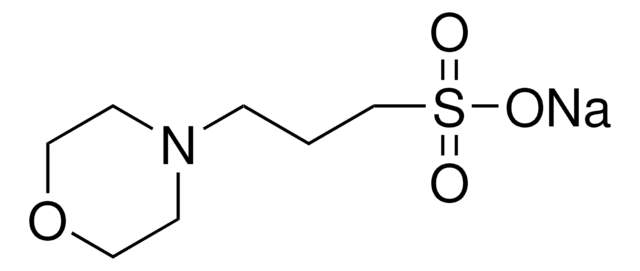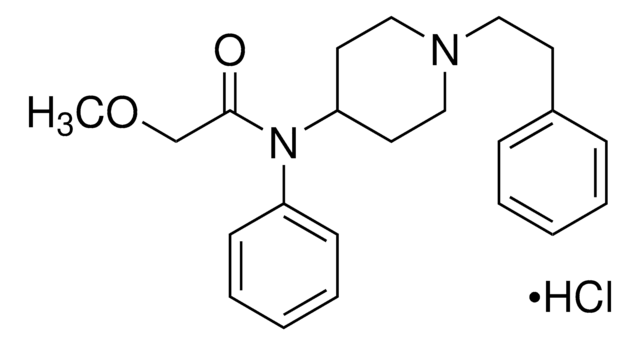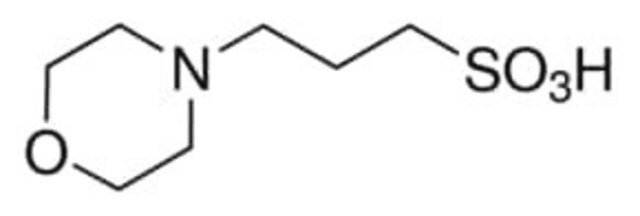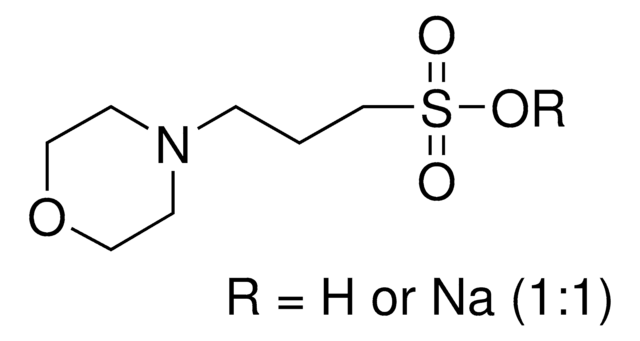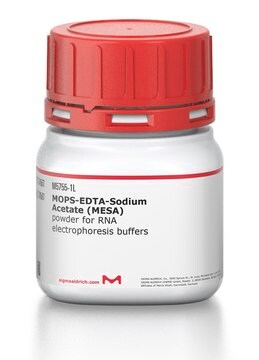Key Documents
M1254
MOPS
≥99.5% (titration), crystalline powder
Synonim(y):
3-(N-Morpholino)propanesulfonic acid, 4-Morpholinepropanesulfonic acid
About This Item
Polecane produkty
product name
MOPS, ≥99.5% (titration)
Poziom jakości
Próba
≥99.5% (titration)
Postać
crystalline powder
warunki przechowywania
dry at room temperature
metody
affinity chromatography: suitable
electrophoresis: suitable
kolor
white
pH
2.5-4 (25 °C, 209 g/L)
przydatny zakres pH
6.5-7.9
pKa (25°C)
7.2
rozpuszczalność
water: 0.5 g/mL, clear, colorless
λ
33 % in H2O
przydatność
suitable for HPLC
Zastosowanie
clinical research
diagnostic assay manufacturing
life science and biopharma
temp. przechowywania
room temp
ciąg SMILES
OS(=O)(=O)CCCN1CCOCC1
InChI
1S/C7H15NO4S/c9-13(10,11)7-1-2-8-3-5-12-6-4-8/h1-7H2,(H,9,10,11)
Klucz InChI
DVLFYONBTKHTER-UHFFFAOYSA-N
Szukasz podobnych produktów? Odwiedź Przewodnik dotyczący porównywania produktów
Powiązane kategorie
Opis ogólny
MOPS serves various functions in diverse research domains. As a buffering agent, it can be used to stabilize pH in cell culture media, promoting optimal cell growth and function. Additionally, it may find application in protein purification in chromatography, stabilizes protein solutions, and acts as a reliable running buffer in various electrophoretic techniques, enabling efficient separation and analysis of biomolecules. MOPS also efficiently lyses cells for subsequent protein or nucleic acid extraction and stabilizes enzymes in solution, ensuring their activity for research purposes. It further proves valuable in fine-tuning the pH of growth media for optimal cell growth.
MOPS possesses additional advantages such as minimal interaction with metal ions especially with copper (Cu), nickel (Ni), manganese (Mn), zinc (Zn), cobalt (Co) ions, making it ideal for studies involving metal ions. It exhibits excellent water solubility, facilitating its use in various buffer formulations, and minimal lipid solubility, ensuring impermeability to membranes and minimizing interference with cellular processes. In summary, MOPS is a reliable buffer widely utilized across diverse biological disciplines, distinguished by its versatility, physiological relevance, minimal metal interaction, and ease of use, with its extensive applications in cell biology, protein studies, electrophoresis, and biochemical research.
Zastosowanie
- a cell culture additive component in lentiviral particle production
- as a buffering agent in microbial growth medium and nuclei extraction buffer
- as a component of the MMSE-A buffer for isolating heart mitochondria
- as a component of the Synthetic Complete (SC) medium
- as a buffer in fluorescence quenching of NADH
Cechy i korzyści
- Ideal for Cell Biology and Biochemical research
- Can be used as a Buffer component for Electrophoresis and Protein separation
- Effective Buffering from pH 6.5-7.9 (25 °C) with a pKa of 7.2 (25 °C)
- Highly soluble in water
- Minimal metal ion binding
Inne uwagi
Kod klasy składowania
11 - Combustible Solids
Klasa zagrożenia wodnego (WGK)
WGK 1
Temperatura zapłonu (°F)
230.0 °F - closed cup
Temperatura zapłonu (°C)
110 °C - closed cup
Środki ochrony indywidualnej
dust mask type N95 (US), Eyeshields, Gloves
Certyfikaty analizy (CoA)
Poszukaj Certyfikaty analizy (CoA), wpisując numer partii/serii produktów. Numery serii i partii można znaleźć na etykiecie produktu po słowach „seria” lub „partia”.
Masz już ten produkt?
Dokumenty związane z niedawno zakupionymi produktami zostały zamieszczone w Bibliotece dokumentów.
Klienci oglądali również te produkty
Nasz zespół naukowców ma doświadczenie we wszystkich obszarach badań, w tym w naukach przyrodniczych, materiałoznawstwie, syntezie chemicznej, chromatografii, analityce i wielu innych dziedzinach.
Skontaktuj się z zespołem ds. pomocy technicznej